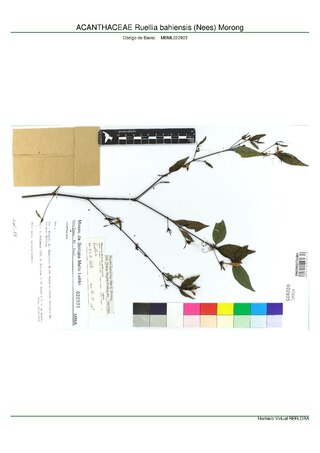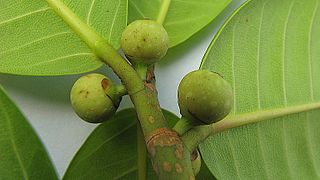
Leocereus is a genus of cactus. Its only species is Leocereus bahiensis, first described by Nathaniel Lord Britton and Joseph Nelson Rose in 1926.
Phoneutria bahiensis is a species of spider in the family Ctenidae, found in Brazil. It is known in Brazilian Portuguese as armadeira da Bahia.

Ruellia bahiensis is a species of flowering plant in the family Acanthaceae. It is a subshrub native to eastern and southern Brazil, where it grows in the Cerrado ecoregion.
Kalyptodoras bahiensis is the only species in the genus Kalyptodoras of the catfish family Doradidae. This species is endemic to Brazil where it is found in the Paraguaçu River in the northeast and reaches a length of 24.5 centimetres (9.6 in) SL.
Cratylia bahiensis is a species of legume in the family Fabaceae. It is found only in Brazil.

Rhodocactus bahiensis is a species of tree-like cactus that is endemic to the Brazilian state of Bahia. First described as Pereskia bahiensis, it was transferred to Rhodocactus in 2016. Like all species in the genus Rhodocactus, and unlike most cacti, it has persistent leaves. In its native locality, it is used to form hedges.
Rollinia bahiensis is a species of plant in the Annonaceae family. It is endemic to Brazil. It is threatened by habitat loss.
Turbonilla bahiensis is a species of sea snail, a marine gastropod mollusk in the family Pyramidellidae, the pyrams and their allies.
Gisostola is a genus of longhorn beetles of the subfamily Lamiinae, containing the following species:
Gisostola melancholica is a species of beetle in the family Cerambycidae. It was described by Thomson in 1857. It is known from Brazil.
Gisostola nordestina is a species of beetle in the family Cerambycidae. It was described by Galileo and Martins in 1987. It is known from Brazil.
Gisostola quentini is a species of beetle in the family Cerambycidae. It was described by Martins and Galileo in 1989. It is known from Brazil.
Ischioderes bahiensis is a species of beetle in the family Cerambycidae. It was described by Monné and Fragoso in 1984. It is known from Brazil.

Discocactus bahiensis is a species of Discocactus from Brazil.
Sebastiania bahiensis is a species of flowering plant in the family Euphorbiaceae. It was originally described as Gymnanthes bahiensisMüll.Arg in 1863. It is native to Bahia, Brazil.

Microtea, the jumby peppers, are a genus of flowering plants in the family Microteaceae, native to the Caribbean islands, Central America, and tropical South America.

Tityus bahiensis is a medically important scorpion endemic to South America.

Ficus bahiensis is a species of tree. It is native to Brazil. The IUCN listed the species as least concern.
Parotocinclus bahiensis is a species of catfish in the family Loricariidae. It is native to South America, where it occurs in the state of Bahia in Brazil, for which it is named. It is a tropical freshwater species that reaches 3.1 cm SL.

Leporinus bahiensis is a species of anostomid fish. It is found in Bahia, Brazil.






